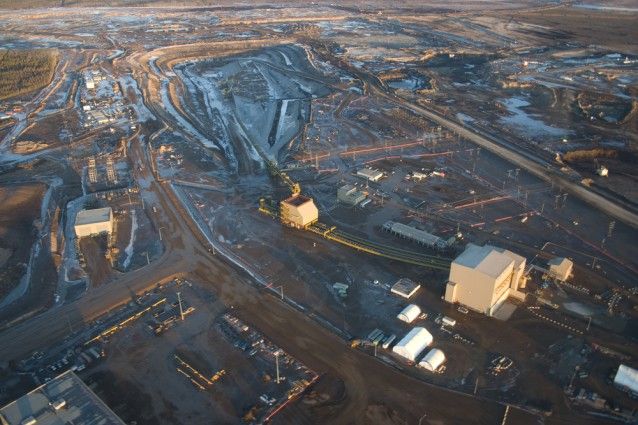
Oilsands development in northern Alberta, Canada. CREDIT: Shutterstock
Scientists have found mercury "wafting" out of oil sands operations in NE Alberta.
According to Canada.com
Levels of the potent neurotoxin found near the massive industrial operation have been found to be up to 16 times higher than “background” levels for the region, says Environment Canada researcher Jane Kirk, who recently reported the findings at an international toxicology conference.snipMercury can bioaccumulate in living creatures and chronic exposure can cause brain damage. It is such a concern that Environment Minister Leona Aglukkaq signed an international treaty in October pledging Canada to further reduce releases to the environment.
The federal scientists stress the mercury loadings around the oilsands are low compared to the contamination seen in many parts of North America including southern Ontario and southern Quebec.Scientists say that the mercury is like a bulls eye with the strongest concentration nearest the extraction zones and the outside rings less toxic. There is, however, mounting evidence that the toxin is building up in the native wildlife.But they say the mercury is “the number one concern” when it comes to the metal toxins generated by oilsands operations. It is also a major worry for aboriginal and environmental groups concerned about the oilsands’ impact on fishing, hunting and important wildlife staging areas downstream of the oilsands.Environment Canada scientists are sampling everything from snow to lichens to bird eggs as part of the federal-provincial joint oilsands monitoring program.Kirk, who will publish the findings in a scientific study in 2014, told the Society of Environmental Toxicology and Chemistry conference in Nashville in November that about 19,000 square kilometres are “currently impacted by airborne Hg (mercury) emissions originating from oilsands developments.”
The highest loadings of mercury were 1,000 nanograms per square metre, much higher than the background level for the region. But she says the “pulse” of mercury in meltwater entering the ecosystem in the spring is below the limits in water quality guidelines for the protection of aquatic life established by the Canadian Council of Ministers of the Environment.The scientists also found up to 19 nanograms of methyl mercury per square metre near the oilsands, 16 times the region’s background level. It is the first report of this more “toxic” form of mercury in snow. Microbes typically convert mercury into methyl mercury when the metal enters aquatic ecosystems and begins to work its way up through the food web.“Here we have a direct source of methyl mercury being emitted in this region and deposited to the landscapes and water bodies,” Kirk said. “So come snowmelt that methyl mercury is now going to enter lakes and rivers where potentially it could be taken up directly by organisms and then bioaccumulated and biomagnified though food webs.”
Think Progress reports:
Giant oil companies across the United States are currently investing in Canada’s tar sands as part of their role in the Keystone XL pipeline, which would carry tar sands oil from Alberta all the way to Texas. The pipeline would double imports of tar sands oil into the United States and transport it to refineries on the Gulf Coast and ports for international export. The oil sands industry itself is undergoing a major expansion, powered by $19 billion a year in investments, according to Bloomberg News.What a nightmare. And TP continues:Mercury pollution is just the latest contamination-related environmental woe to hit the tar sands. In May of this year, leaks of the oil started popping up in Alberta, and haven’t yet stopped. In September, the company responsible for the leaks was ordered to drain a lake so that contamination on the lake’s bottom could be cleaned up. By September 11, the leaks had spilled more than 403,900 gallons — or about 9,617 barrels — of oily bitumen into the surrounding boreal forest and muskeg, the acidic, marshy soil found in the forest.
The contamination’s reveal comes just one week after it was revealed that the Alberta government would hand over regulatory responsibility for the province’s tar sands industry to a corporation that’s funded entirely by Canada’s oil, coal and gas industry. The Alberta Energy Regulator (AER) said it would take over the duties of the now defunct Energy Resources Conservation Board (ERCB) — which was funded in part by taxpayers — and Alberta Environment and Sustainable Resource Development.The shift to the AER as the main environmental regulator in Alberta is part of the provincial government’s plan to streamline the approval process for oil companies. It’s drawn concern from environmentalists in Alberta, who are worried that the AER’s financial backing from the fossil fuel industry makes the group too close to the industry it’s supposed to regulate.
No comments:
Post a Comment